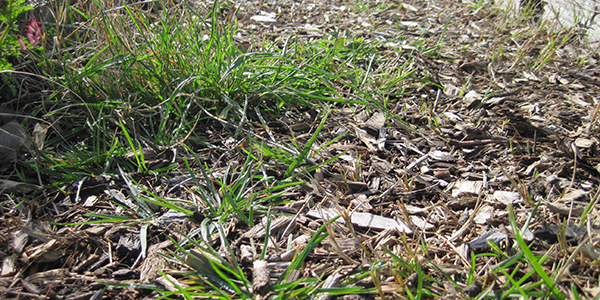All mulching materials can be spread over vegetable beds as is, but most will be improved considerably if they are first processed to break them down to make them easier to spread. One of the best ways to do this is with a deep litter chicken pen.
A deep litter chicken pen is a sectioned off area that is regularly filled with mulching materials (such as straw and pea straw) and that chickens have access to. The sides keeping the chickens in can be made of mesh but the base needs to be solid (about 20 to 40 cm high) to keep the mulching material from spreading beyond the pen.
As the chicken’s scratch at the mulching materials and the ground beneath it in their quest for seeds, insects, and worms they will begin to break down the mulch into smaller pieces. In doing so they also remove weed seeds and fertilise the mulch with their faeces. Combined with the anaerobic action of the bacteria breaking down the mulch and you will eventually end up with much finer mulch than if it had not been processed.

A deep litter chicken run is an ideal way to process mulch. Not only do chickens efficiently break down the mulch they also pick out most of the weed seeds and add fertiliser in the form of their droppings.
Optimum size for a deep litter chicken pen can vary, depending on: –
- THE NUMBER OF CHICKENS
The number of chickens accessing the deep letter pen should be proportional to the size of the pen. Too few chickens and the mulch will take longer to break down. Too many and this may exacerbate pecking order tensions due to lack of space. - HOW MUCH MULCH IS REQUIRED
How big a pen should be governed by how much mulch you use in your garden. The larger the pen the bigger the batch of mulch that can be processed at one time. Too big a pen and you will end up with more processed mulch than you can comfortably use.
Processing times vary depending on the season and the number of chickens accessing the pen. The more chickens per square metre of pen the more vigorously the mulch will be turned over.
But the anaerobic bacterial action is also important. In Summer dry weather will slow this anaerobic action. Dry mulch takes longer to break down. In winter, while the mulch is wetter (moisture encourages anaerobic action), the anaerobic action is even slower as cold slows bacterial activity. The best conditions for breaking down mulch usually occur in spring and autumn when the mulch is both moist and warm.
There is also a time difference between how long each type of mulch takes to break down. For instance, I have found that straw breaks down quicker than Lucerne.
Depending on these above factors it generally takes between five and eight weeks to turn fresh mulching materials into a premium mulch.

LEFT: Fresh unprocessed straw. RIGHT: Straw and pea straw after it has been processed in my deep litter pen.
If mulch is left long enough in a deep litter pen it will start breaking down into compost. That is fine if you want compost, but if you want quality mulch then it needs to be used when it is reached its peak.
Ideally, to save double handling, mature mulch should be spread directly on your vegetable beds. But if you do not need it straight away it needs to be stored in a dry place to slow down the bacterial process until you are ready to use it. A dry corner in a shed would be ideal, but as I do not have any spare shed space, I store my surplus mulch in old wheelie bins.

Mature processed mulch stored in an old wheelie bin until it is needed. Keeping mulch dry does not stop it breaking down further but it does slow the process down.




